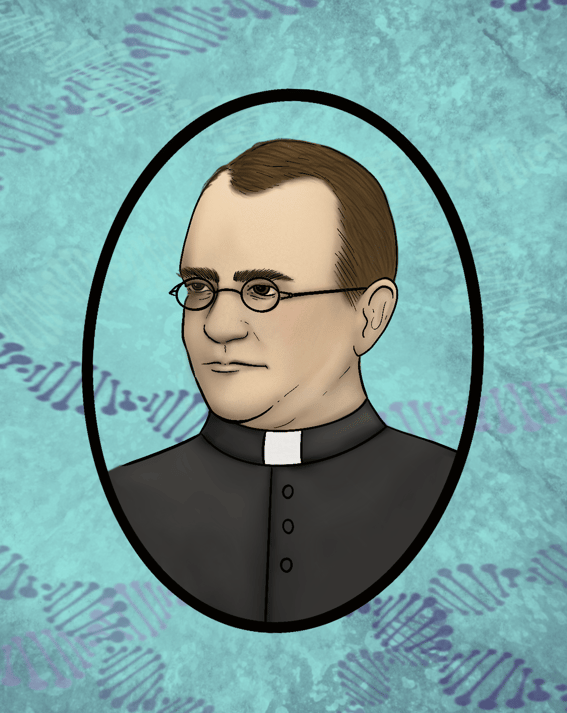Genomics101: The History of heredity.
Welcome back to Genomics101, GenomicMD’s ongoing blog series dedicated to helping you grow a foundational knowledge about genomics without all the over-complicated scientific lingo. Since we laid a basic foundational understanding of the structure of DNA and what mutations and variants are in our first 2 posts, we thought it would be nice to go back to the beginning of genetics and give a short history lesson about how it all began. Much of what we currently know about heredity, or how organisms pass traits down from parent to offspring, is based on the studies of one man–so today’s blog is going to cover the story of Gregor Mendel, sometimes called the father of modern genetics, and help you understand his life and how the science of heredity came to be.

Johann Mendel was born on July 20th, 1822 in rural Heinzendorf, Silesia (formerly part of the Austrian Empire but now part of the Czech Republic) into a family of limited means. As a child he excelled in his village school and also fostered a keen interest in what would come to be known as his specialty–plant genetics while grafting fruit trees with his father on their small family farm. Eventually a local priest took notice of Mendel’s academic talent and was able to convince his family to send him away to an established grammar school at the age of 11, which was no small feat for his family’s meager farming budget. He excelled throughout grammar school and was soon accepted into a 2 year program at the Philosophical Institute of the University of Olmutz. These initial years away from home were hard and wrought with strife for Mendel. This was especially true after his father sustained a traumatic injury while working in the woods, thereby causing a setback for the family that meant his parents were no longer able to fully support him financially. Around this time one of his young sisters decided to give up a large portion of her family inheritance to help further his education–but despite her generosity Johann still had to take on tutoring jobs to help pay for his schooling and suffered from severe depression which required him to return home at intervals to recover.
Eventually, Mendel decided to drop out of University altogether due to poverty, or as he called it: “bitter food worries,” despite his high marks. At this point one of his teachers, a physics professor named Friedrich Franz, offered the suggestion of joining an Abbey as a monk in order to continue his studies without worrying about finances. Despite being more fascinated by science than religion, Mendel decided to join the Abbey of St. Thomas, officially taking on the name “Gregor” and entering the ranks of the clergy. During this time, Gregor was able to further his scientific interest in plants along with his theological studies by taking fruit-growing classes in 1846 taught by a professor named Franz Diebl, who was an expert in the science of plant-breeding. These classes helped form the foundational knowledge of his future research. After completing his various studies in 1847, he became a full member of the clergy and inherited his own parish in 1848. Gregor did not much enjoy the work of being a parish priest, and upon seeing a rise in his feelings of depression caused by the duties of visiting the ill and dying, an Abbot named Cyril Napp helped find him a substitute teaching job.
Gregor enjoyed sharing his knowledge with high-school students for many years until new legislation was introduced in Vienna in 1850 that required certification for teachers. Despite his great personal success with students and connection to the subjects of physics and natural history, Gregor failed his certification exam and decided to go back to school to benefit from additional scientific training. During this training, he was able to further study physics, mathematics, anatomy, and the physiology of plants through use of the microscope. He was also able to learn more rigorous methods for experimentation from famed physicist Christian Doppler, which he was able to apply to his later experiments with cross-breeding plants. Despite this additional training, Gregor suffered a nervous breakdown from stress and failed the teaching certification exam once again in 1856 – after which he decided to commit full-time to his growing abbot duties and personal experiments.
Despite this painful setback, Gregor completed his most influential work in the 8 years after his failure to become a teacher. He devoted this time to specific research projects surrounding inheritance in edible pea plants, which he chose because of how quick and easy they were to grow and their high number of observable traits. These experiments, based in his laboratory in Brno (where some of his plants’ descendants still thrive today!) focused on cross-breeding different varieties of pea-plants and observing the traits that appeared across generations, or groups of individual organisms living and reproducing at the same time. Mendel’s primary focus in these experiments was finding out what happens to the offspring of each generation when you cross plants with specific traits such as height, flower color & placement, seed color & shape, and pod color & shape with each other. During the course of these tests Gregor noticed that when crossing certain characteristics with each other, for instance cross-breeding purple-flowered plants with white-flowered plants, the next generation would only express one of the characteristics–such as only having purple flowers. If he then crossed this generation with each other, the traits that disappeared (white flowers) would reappear in 1/4 of the offspring. His prior instruction in mathematics helped him realize this 3 to 1 ratio as a pattern in all of the traits he studied, whether using the original plant varieties or his new hybrid plants. These studies and the resulting mathematical ratios noticed during the course of his experiments allowed him to conclude that peas have 2 distinct units of inheritance for each of the traits observed. Today these units of variation in gene pairs are called alleles.

After continuous and rigorous testing on his more than 28,000 plants, Gregor was able to statistically validate his results and relate this new knowledge to subjects like cell theory taught to him by Christian Doppler during his schooling. In crafting his hypothesis, he came up with two new terms to explain his theories that are still used today: dominant and recessive. The term dominant was used by Mendel to refer to traits that masked others in the first generation of breeding, such as how only purple flowers showed up when crossing with plants who had white flowers. In contrast, the term recessive was used to refer to traits that reappeared in the second generation, such as how the white flowers showed back up after breeding the new hybrid plants with each other. Mendel first presented his theories on heredity in 1865 in lectures at the National Science Society in Brunn, and published his paper “Experiments on Plant Hybrids” in the society’s journal a year later. Despite his revolutionary findings, the public did not widely understand the implications of his work, considering it too abstract and thus it was received with much skepticism. This did not deter Mendel from understanding the groundbreaking nature of his hypothesis, who was quoted as saying “my time will come.” Indeed, his time DID come when over 30 years after his 1884 death, 3 scientists independently rediscovered his hypothesis through their own experimentation and found his forgotten papers. After this rediscovery the scientists were able to easily replicate Mendel’s findings and thus the new science of genetics was finally born, with Mendel ultimately receiving the respect he deserved as the “father of modern genetics”.
We hope that you enjoyed this short lesson on the life of Gregor Mendel and the history of heredity. Our next 2 chapters will go into additional detail on the concept of dominant and recessive traits, how they’re expressed in families, and how it all relates to concepts like ancestry and ethnicity. We hope the next few posts will help you develop a better understanding of what Mendel’s theories mean in the context of human genomics, as well as how all of these things play into the concept of personal genetic risk, so stay tuned!
Blog Glossary:
Heredity/Inheritance - The transmission of traits from one generation to the next
Generation - A group of individual organisms that live and reproduce within the same time frame.
Alleles - A unit of variation in a pair of genes. We inherit one of these from each of our parents and they can be dominant or recessive.
Dominant - A dominant allele is one that will consistently produce the same trait even when inherited in a pair with a non-identical allele
Recessive - A recessive allele is one that will not produce a specific trait if inherited with a dominant allele. Recessive alleles need 2 copies for a trait to be expressed.